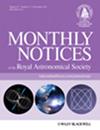The JWST EXCELS survey: too much, too young, too fast? Ultra-massive quiescent galaxies at 3 < z < 5
IF 4.8
3区 物理与天体物理
Q1 ASTRONOMY & ASTROPHYSICS
引用次数: 0
Abstract
We report ultra-deep, medium-resolution spectroscopic observations for four quiescent galaxies with log$_{10}(M_*/\mathrm{M_\odot })\gt 11$ at $3 \lt z \lt 5$. These data were obtained with JWST NIRSpec as part of the Early eXtragalactic Continuum and Emission Line Science (EXCELS) survey, which we introduce in this work. The first two galaxies are newly selected from PRIMER UDS imaging, both at $z=4.62$ and separated by 860 pkpc on the sky, within a larger structure for which we confirm several other members. Both formed at $z\simeq 8-10$. These systems could plausibly merge by the present day to produce a local massive elliptical galaxy. The other two ultra-massive quiescent galaxies are previously known at $z=3.99$ and 3.19, with the latter (ZF-UDS-7329) having been the subject of debate as potentially too old and too massive to be accommodated by the $\Lambda$-CDM halo-mass function. Both exhibit high stellar metallicities, and for ZF-UDS-7329 we are able to measure the $\alpha -$enhancement, obtaining [Mg/Fe] = $0.42^{+0.19}_{-0.17}$. We finally evaluate whether these four galaxies are consistent with the $\Lambda$-CDM halo-mass function using an extreme value statistics approach. We find that the $z=4.62$ objects and the $z=3.19$ object are unlikely within our area under the assumption of standard stellar fractions ($f_*\simeq 0.1-0.2$). However, these objects roughly align with the most massive galaxies expected under the assumption of 100 per cent conversion of baryons to stars ($f_*$=1). Our results suggest extreme galaxy formation physics during the first billion years, but no conflict with $\Lambda$-CDM cosmology.JWST EXCELS巡天:太多、太年轻、太快?3 < z < 5的超大质量静态星系
我们报告了在3 \lt z \lt 5$时对四个log$_{10}(M_*/\mathrm{M_\odot })\gt 11$的静止星系进行的超深度、中等分辨率光谱观测。这些数据是用JWST NIRSpec获得的,是早期河外星系连续和发射线科学(EXCELS)巡天的一部分。前两个星系是从PRIMER UDS成像中新挑选出来的,都位于$z=4.62$,在天空中相距860 pkpc,在一个更大的结构中,我们确认了其他几个成员。两者都形成于 $z\simeq 8-10$。这些星系有可能在今天合并成一个本地的大质量椭圆星系。另外两个超大质量静态星系是以前已知的,分别位于$z=3.99$和3.19,其中后者(ZF-UDS-7329)一直是争论的主题,因为它可能太老太大,无法被$\Lambda$-CDM光环质量函数所容纳。这两个星系都表现出了很高的恒星金属性,对于ZF-UDS-7329,我们能够测量出其α-$增强,得到[Mg/Fe] = $0.42^{+0.19}_{-0.17}$。最后,我们用极值统计方法来评估这四个星系是否与$\Lambda$-CDM晕质量函数相一致。我们发现,在标准恒星分数($f_*\simeq 0.1-0.2$)假设下,$z=4.62$天体和$z=3.19$天体不太可能出现在我们的区域内。然而,这些天体与假定重子100%转化为恒星($f_*$=1)时预计的质量最大的星系基本一致。我们的结果表明,在最初的十亿年里,星系形成的物理过程非常极端,但是与$\Lambda$-CDM宇宙学并不冲突。
本文章由计算机程序翻译,如有差异,请以英文原文为准。
求助全文
约1分钟内获得全文
求助全文
来源期刊

Monthly Notices of the Royal Astronomical Society
ASTRONOMY & ASTROPHYSICS-
CiteScore
9.10
自引率
37.50%
发文量
3198
审稿时长
3 months
期刊介绍:
Monthly Notices of the Royal Astronomical Society is one of the world''s leading primary research journals in astronomy and astrophysics, as well as one of the longest established. It publishes the results of original research in positional and dynamical astronomy, astrophysics, radio astronomy, cosmology, space research and the design of astronomical instruments.
 求助内容:
求助内容: 应助结果提醒方式:
应助结果提醒方式:


